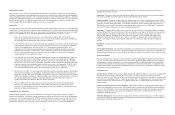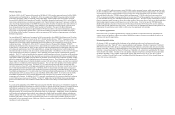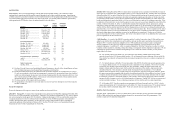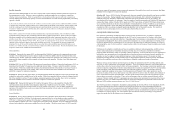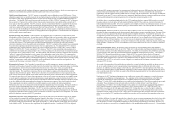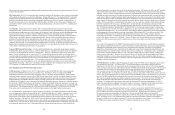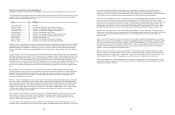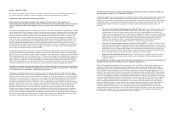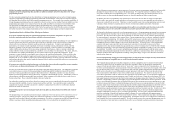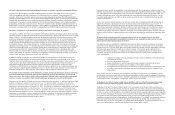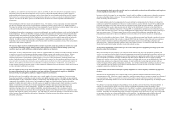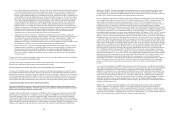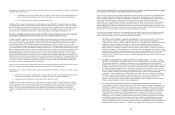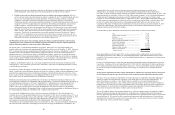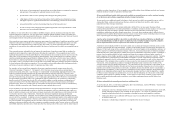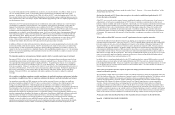Dish Network 2012 Annual Report Download - page 18
Download and view the complete annual report
Please find page 18 of the 2012 Dish Network annual report below. You can navigate through the pages in the report by either clicking on the pages listed below, or by using the keyword search tool below to find specific information within the annual report.24
24
We face increasing competition from other distributors of unique programming services such as foreign
language and sports programming that may limit our ability to maintain subscribers that desire these unique
programming services.
We face increasing competition from other distributors of unique programming services such as foreign language
and sports programming, including programming distributed over the Internet. There can be no assurance that we
will maintain subscribers that desire these unique programming services. For example, the increasing availability of
foreign language programming from our competitors, which in certain cases has resulted from our inability to renew
programming agreements on an exclusive basis or at all, could contribute to an increase in our subscriber churn.
Our agreements with distributors of foreign language programming have varying expiration dates, and some
agreements are on a month-to-month basis. There can be no assurance that we will be able to grow or maintain
subscribers that desire these unique programming services such as foreign language and sports programming.
Operational and Service Delivery Risks Affecting our Business
If we do not continue improving our operational performance and customer satisfaction, our gross new
subscriber activations may decrease and our subscriber churn may increase.
If we are unable to continue improving our operational performance and customer satisfaction, we may experience a
decrease in gross new subscriber activations and an increase in subscriber churn, which could have a material
adverse effect on our business, financial condition and results of operations. To improve our operational
performance, we continue to make significant investments in staffing, training, information systems, and other
initiatives, primarily in our call center and in-home service operations. These investments are intended to help
combat inefficiencies introduced by the increasing complexity of our business, improve customer satisfaction,
reduce subscriber churn, increase productivity, and allow us to scale better over the long run. We cannot, however,
be certain that our spending will ultimately be successful in improving our operational performance. In the
meantime, we may continue to incur higher costs to improve our operational performance. While we believe that
these costs will be outweighed by longer-term benefits, there can be no assurance when or if we will realize these
benefits at all. If we are unable to improve our operational performance, our future gross new subscriber activations
and existing subscriber churn may be negatively impacted, which could in turn adversely affect our revenue growth
and results of operations.
If our gross new subscriber activations decrease, or if subscriber churn, subscriber acquisition costs or retention
costs increase, our financial performance will be adversely affected.
We may incur increased costs to acquire new subscribers and retain existing subscribers. Our subscriber acquisition
costs could increase as a result of increased spending for advertising and the installation of more HD and DVR
receivers, which are generally more expensive than other receivers. Meanwhile, retention costs may be driven
higher by increased upgrades of existing subscribers’ equipment to HD and DVR receivers. Additionally, certain of
our promotions, including, among others, pay-in-advance, allow consumers with relatively lower credit scores to
become subscribers. These subscribers typically churn at a higher rate.
Our subscriber acquisition costs and our subscriber retention costs can vary significantly from period to period and
can cause material variability to our net income (loss) and free cash flow. Any material increase in subscriber
acquisition or retention costs from current levels could have a material adverse effect on our business, financial
position and results of operations.
Programming expenses are increasing and could adversely affect our future financial condition and results of
operations.
Our programming costs currently represent the largest component of our total expense and we expect these costs to
continue to increase. The pay-TV industry has continued to experience an increase in the cost of programming,
especially local broadcast channels and sports programming. Our ability to compete successfully will depend on our
ability to continue to obtain desirable programming and deliver it to our subscribers at competitive prices.
25
25
When offering new programming, or upon expiration of existing contracts, programming suppliers have historically
attempted to increase the rates they charge us for programming. We expect this practice to continue, which, if
successful, would increase our programming costs. As a result, our margins may face further pressure if we are
unable to renew our long-term programming contracts on favorable pricing and other economic terms.
In addition, increases in programming costs could cause us to increase the rates that we charge our subscribers,
which could in turn cause our existing subscribers to disconnect our service or cause potential new subscribers to
choose not to subscribe to our service. Therefore, we may be unable to pass increased programming costs on to our
customers, which could have a material adverse effect on our financial condition and results of operations.
We depend on others to provide the programming that we offer to our subscribers and, if we lose access to this
programming, our gross new subscriber activations may decline and subscriber churn may increase.
We depend on third parties to provide us with programming services. Our programming agreements have remaining
terms ranging from less than one to up to several years and contain various renewal, expiration and/or termination
provisions. We may not be able to renew these agreements on favorable terms or at all, and these agreements may
be terminated prior to expiration of their original term. Certain programmers have, in the past, temporarily limited
our access to their programming. For example, during 2012, our gross new subscriber activations and subscriber
churn were negatively impacted as a result of multiple programming interruptions and threatened programming
interruptions related to contract disputes with several content providers. We typically have a few programming
contracts with major content providers up for renewal each year and if we are unable to renew any of these
agreements or the other parties terminate the agreements, there can be no assurance that we would be able to obtain
substitute programming, or that such substitute programming would be comparable in quality or cost to our existing
programming. In addition, loss of access to programming, particularly programming provided by major content
providers and/or programming popular with our subscribers, could have a material adverse effect on our business,
financial condition and results of operations, including, among other things, our gross new subscriber activations
and subscriber churn rate.
Our local programming strategy faces uncertainty because we may not be able to obtain necessary retransmission
consent agreements at acceptable rates, or at all, from local network stations.
The Copyright Act generally gives satellite companies a statutory copyright license to retransmit local broadcast
channels by satellite back into the market from which they originated, subject to obtaining the retransmission
consent of local network stations that do not elect “must carry” status, as required by the Communications Act. If
we fail to reach retransmission consent agreements with such broadcasters, we cannot carry their signals. This could
have an adverse effect on our strategy to compete with cable and other satellite companies that provide local signals.
While we have been able to reach retransmission consent agreements with most of these local network stations,
there remain stations with which we have not been able to reach an agreement. We cannot be sure that we will
secure these agreements or that we will secure new agreements on acceptable terms, or at all, upon the expiration of
our current retransmission consent agreements, some of which are short-term. During the second quarter 2012, the
four major broadcast television networks filed lawsuits against us alleging, among other things, that the PrimeTime
Anytime™ and AutoHop™ features of the Hopper set-top box breach their retransmission consent agreements. In the
event a court ultimately determines that we breached the terms of these retransmission consent agreements, we may
be subject, among other things, to substantial damages and we may lose access to programming or may not be able
to renew certain of our retransmission consent agreements and other programming agreements on favorable terms or
at all. Even if we ultimately prevail in these actions, there can be no assurance that we will be able to renew our
retransmission consent agreements or enter into new agreements with these broadcast networks. In such event, there
can be no assurance that we will be able to obtain substitute programming, or that such substitute programming
would be comparable in quality or cost to our existing programming. In recent years, national broadcasters have
used their ownership of certain local broadcast stations to require us to carry additional cable programming in
exchange for retransmission consent of their local broadcast stations. These requirements may place constraints on
available capacity on our satellites for other programming. Furthermore, the rates we are charged for retransmitting
local channels have been increasing substantially. We may be unable to pass these increased programming costs on
to our customers, which could have a material adverse effect on our financial condition and results of operations.


